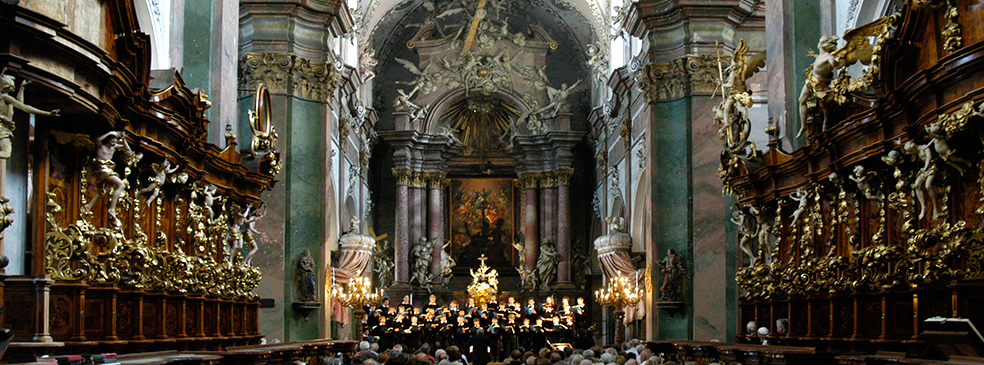
Das Kloster Osek
«« zurückGeschichte
Ein Spiegel der böhmischen und europäischen Vergangenheit, ein wechselvolles Auf und Ab, ist die über 800jährige Geschichte des Klosters Ossegg, zu der Jahre des Wohlstands und Einflusses ebenso gehören wie Zeiten der Bedrängnis und des Niedergangs. Bemerkenswert bleibt, dass die Zisterzienser immer wieder nach Ossegg zurückkehrten und sich den Herausforderungen eines Neuanfangs stellten.
Dem Engagement seiner Mönche und der Weitsicht seiner Äbte verdankt Ossegg sein einzigartiges und bis heute lebendiges Kloster. Schon bald nach seiner Gründung 1098 im burgundischen Citeaux war der Orden der Weißen Mönche zur treibenden Kraft der Christianisierung geworden und verbreitete das Wissen um Agrar-, Forst- und Wasserwirtschaft, Architektur und fortschrittliches Handwerk über ganz Europa.
Auf Einladung Slavkos von Hrabischitz, Kämmerer des Königreichs Böhmen und Burggraf in Bilin, kommen Zisterzienser aus dem oberpfälzischen Waldsassen und gründen 1196 das Kloster Ossegg.
Mit der romanischen Abteikirche beginnt in den Jahren 1206 bis 1221 der Bau des steinernen Klosters. Darauf folgen die Konventgebäude, deren Baustil schrittweise von der Romanik zur Gotik übergeht. Der Ostflügel mit dem berühmten Kapitelsaal entsteht unter Slavko von Hrabischitz, der als Enkel des Gründers etwa um 1234 erster böhmischer Abt von Ossegg wird. Der kontinuierliche Aufstieg des Klosters endet mit den Hussiten Kriegen. 1421 kommt es zur ersten Verwüstung der Abtei, einen weiteren Überfall 1429 überleben nur wenige Mönche. Das Kloster führt von da an ein kümmerliches Dasein, veräußert mehr und mehr seiner Güter, bis es im Jahre 1580 - im hoch verschuldeten Kloster leben nur noch sechs Mönche - schließlich aufgelöst und auf 46 Jahre zum Sommersitz der Prager Erzbischöfe gemacht wird.
Erst 1626 wird Ossegg den Zisterziensern zurückgegeben. Zu seiner großen Blüte kommt das Ossegger Kloster nach dem Dreißigjährigen Krieg. 1650 tritt Laurentius Scipio an, der die Abtei sehr erfolgreich durch vier Jahrzehnte führt und den Grundstein für Jahrhunderte des Wohlstands und nachhaltigen Einflusses auf Nordböhmen legt. Die im Krieg ausgebrannte Kirche wird erneuert und die Werkstätten, Meierhöfe und Wirtschaftsgebäude ausgebaut. Ein großer Obst- und Gemüsegarten entsteht westlich des Klosters.
Der Nachfolger Scipios kann sich bereits auf einem stabilen wirtschaftlichen Fundament dem Ausbau seiner Abtei widmen. Benedikt Littwerig, Abt von 1691 bis 1726, veranlasst die barocken Umbauten, Erweiterungen und Ausschmückungen, die das Bild der Abtei bis heute prägen. Für die Baumaßnahmen werden die seinerzeit führenden Baumeister Giulio und Octavian Broggio gewonnen. Sechs Jahre benötigt man, bis die detailreiche Umgestaltung der Kirche im Jahre 1718 abgeschlossen werden kann. Es entstehen Prälatur, Brauerei, Klosterbibliothek, Apotheke und eine erste Textilmanufaktur.
Abt Hieronymus Besnecker lässt die großen Barockgärten anlegen - ab 1726 den Abtgarten vor dem Ostflügel der neuen Prälatur und ab 1728 den Konventgarten südlich des Klosters.
Abt Mauritz Elbel verteidigt Ossegg - als eines von nur zwei böhmischen Zisterzienserklöstern - mit Erfolg gegen die von Kaiser Josef II. angestrengten Reformen und Klosterschließungen von 1783. Der Abt gründet die Bildergalerie, das naturwissenschaftliche Kabinett, er lässt den Abtsaal aufwendig gestalten und den Abtgarten auf seine bis heute erhaltene Größe erweitern.
Das 19. Jahrhundert sieht das Kloster Ossegg vor allem als Ort der Literatur und Wissenschaft, des sozialen und kirchenpolitischen Engagements und als wirtschaftliches Unternehmen, das seine Erträge aus Kohlegruben, dem Obstbau und der Verpachtung seines umfangreichen landwirtschaftlichen Besitzes erzielt. In den Jahren 1875 bis 1877 werden unter den Äbten Sales Anton Mayer und Ignaz Peter Krahl das Kloster komplett renoviert und die Gärten im landschaftlichen Stil umgestaltet.
Unter Abt Theobald Scharnagl erlebt das Kloster Ossegg beide Weltkriege und 1921 die Verkleinerung des Klosterbesitzes durch die Agrarreform. 1943 übernimmt Abt Eberhard Harzer das Kloster, 1945 wird er gemeinsam mit den deutschen Mönchen interniert und 1946 nach Österreich ausgewiesen. Bis 1950 leben Salesianer im Kloster, bevor hier ein Internierungslager für Ordenspriester und ab 1953 für tschechische Nonnen verschiedener Orden entsteht.




